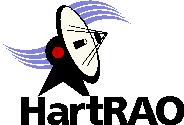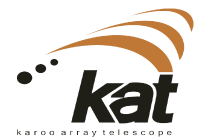
Click on image for LARGE version
Setting up one of the Radio Frequency Interference moitoring systems on site in the Karoo.


HartRAO Home > news > New Karoo Array Telescope 2006/05/10
Together with Australia, China and Argentina, South Africa is on the shortlist to host the world's largest radio telescope, the Square Kilometre Array, or (SKA). "Competition in this bid is tough, as the winning country will attract a billion euro investment and one of the most ambitious science projects ever" says Dr Bernie Fanaroff, South Africa's SKA Project Manager. "The winner in the SKA bid will only be known by 2008, but in the mean time we are planning to build the Karoo Array Telescope, or KAT, in the same region where we hope to site the core of the SKA."
The KAT will have about 1% of the SKA's receiving capacity, but it will still be a powerful radio telescope in its own right. It will also prove that South Africa is committed and ready to host the SKA. Alongside the new Southern African Large Telescope (SALT), KAT will further boost South Africa's profile as a premier astronomy destination. "Our government recognizes the power of astronomy as a tool to put South African science on the world stage and to boost development within the country" Dr Fanaroff adds.
A radio telescope has to be as far away as possible from man-made sources of radio waves. For months the SKA team worked closely with the Independent Communications Authority of South Africa (ICASA) to measure radio frequency interference (RFI) levels in some of the most remote parts of South Africa as part of the process to find the best place to build the telescope. They have identified three sites in a radio quiet valley in the Karoo, where surrounding mountains provide extra shielding against radio waves from remote metropolitan areas. They will select the final site after even more RFI results and infrastructure costs have been compared.
According to Dr Fanaroff, KAT must perform first light experiments by the end of 2009. "To achieve this, we have to move the first dishes for the full KAT array, about 20 dishes of 15 m diameter each, onto site by May 2008" he says. "By then the basic infrastructure, such as roads, electricity, water and sewage must also be in place." The KAT team and other contractors around the country are working towards these deadlines. While some are developing the sophisticated software and digital signal processing hardware and firmware, others are doing research to develop state-of-the-art receiver and feed systems, designing the dishes or refining the work on the selection on the physical site. The KAT software will evolve through a series of prototypes, starting with the Production Equivalent Demonstrator (PED) to be tested at the South African Astronomical Observatory (SAAO) in Cape Town.
A single 15 m prototype dish to test feeds, signal processing equipment and software will be built by IST Dynamics (Pty) Ltd at the Hartebeesthoek Radio Astronomy Observatory (HartRAO). "This dish will not only be the test bed for all KAT components, but it will also strengthen our industry's capacity to design and construct large dishes, says Anita Loots, KAT Project Manager. "This will make it possible for South African industry to compete for contracts on SKA." The KAT prototype has to be ready by mid 2007.
According to Kim de Boer at the SKA project office in Johannesburg, there will be many opportunities for postgraduate students to get involved in the KAT project. "KAT will be commissioned in phases and along the way we expect many exciting research opportunities to open up" she says.
The KAT team is working closely with radio astronomy teams in Australia, the UK, Netherlands and the USA. "Our collaboration with international partners will greatly reduce the cost and risks of building KAT" says Dr Fanaroff.
KAT enjoys the support of several local research organizations and government departments, but the team is also working hard on finding more funding partners to make KAT a truly world class instrument. The project operates under the auspices of the Department of Science and Technology. Key contacts:
